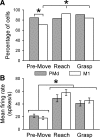Signaling of grasp dimension and grasp force in dorsal premotor cortex and primary motor cortex neurons during reach to grasp in the monkey
- PMID: 19403752
- PMCID: PMC2712255
- DOI: 10.1152/jn.00016.2009
Signaling of grasp dimension and grasp force in dorsal premotor cortex and primary motor cortex neurons during reach to grasp in the monkey
Abstract
A fundamental question is how the CNS controls the hand with its many degrees of freedom. Several motor cortical areas, including the dorsal premotor cortex (PMd) and primary motor cortex (M1), are involved in reach to grasp. Although neurons in PMd are known to modulate in relation to the type of grasp and neurons in M1 in relation to grasp force and finger movements, whether specific parameters of whole hand shaping are encoded in the discharge of these cells has not been studied. In this study, two monkeys were trained to reach and grasp 16 objects varying in shape, size, and orientation. Grasp force was explicitly controlled, requiring the monkeys to exert either three or five levels of grasp force on each object. The animals were unable to see the objects or their hands. Single PMd and M1 neurons were recorded during the task, and cell firing was examined for modulation with object properties and grasp force. The firing of the vast majority of PMd and M1 neurons varied significantly as a function of the object presented as well as the object grasp dimension. Grasp dimension of the object was an important determinant of the firing of cells in both PMd and M1. A smaller percentage of PMd and M1 neurons were modulated by grasp force. Linear encoding was prominent with grasp force but less so with grasp dimension. The correlations with grasp dimension and grasp force were stronger in the firing of M1 than PMd neurons and across both regions the modulation with these parameters increased as reach to grasp proceeded. All PMd and M1 neurons that signaled grasp force also signaled grasp dimension, yet the two signals showed limited interactions, providing a neural substrate for the independent control of these two parameters at the behavioral level.
Figures











Similar articles
-
Encoding of Both Reaching and Grasping Kinematics in Dorsal and Ventral Premotor Cortices.J Neurosci. 2017 Feb 15;37(7):1733-1746. doi: 10.1523/JNEUROSCI.1537-16.2016. Epub 2017 Jan 11. J Neurosci. 2017. PMID: 28077725 Free PMC article.
-
Primary motor cortex neuronal discharge during reach-to-grasp: controlling the hand as a unit.Arch Ital Biol. 2002 Jul;140(3):229-36. Arch Ital Biol. 2002. PMID: 12173526
-
Encoding of reach and grasp by single neurons in premotor cortex is independent of recording site.J Neurophysiol. 2007 May;97(5):3351-64. doi: 10.1152/jn.01328.2006. Epub 2007 Mar 14. J Neurophysiol. 2007. PMID: 17360824
-
Representation of Muscle Synergies in the Primate Brain.J Neurosci. 2015 Sep 16;35(37):12615-24. doi: 10.1523/JNEUROSCI.4302-14.2015. J Neurosci. 2015. PMID: 26377453 Free PMC article. Review.
-
The cognitive neuroscience of prehension: recent developments.Exp Brain Res. 2010 Aug;204(4):475-91. doi: 10.1007/s00221-010-2315-2. Epub 2010 Jun 8. Exp Brain Res. 2010. PMID: 20532487 Free PMC article. Review.
Cited by
-
Decoding action intentions from preparatory brain activity in human parieto-frontal networks.J Neurosci. 2011 Jun 29;31(26):9599-610. doi: 10.1523/JNEUROSCI.0080-11.2011. J Neurosci. 2011. PMID: 21715625 Free PMC article.
-
The Neural Representation of Force across Grasp Types in Motor Cortex of Humans with Tetraplegia.eNeuro. 2021 Feb 19;8(1):ENEURO.0231-20.2020. doi: 10.1523/ENEURO.0231-20.2020. Print 2021 Jan-Feb. eNeuro. 2021. PMID: 33495242 Free PMC article.
-
Spatiotemporal variation of multiple neurophysiological signals in the primary motor cortex during dexterous reach-to-grasp movements.J Neurosci. 2011 Oct 26;31(43):15531-43. doi: 10.1523/JNEUROSCI.2999-11.2011. J Neurosci. 2011. PMID: 22031899 Free PMC article.
-
Corticospinal excitability underlying digit force planning for grasping in humans.J Neurophysiol. 2014 Jun 15;111(12):2560-9. doi: 10.1152/jn.00815.2013. Epub 2014 Feb 5. J Neurophysiol. 2014. PMID: 24501267 Free PMC article.
-
Shifts in Estimated Preferred Directions During Simulated BMI Experiments With No Adaptation.Front Syst Neurosci. 2021 Jul 19;15:677688. doi: 10.3389/fnsys.2021.677688. eCollection 2021. Front Syst Neurosci. 2021. PMID: 34349626 Free PMC article.
References
-
- Ashe J, Georgopoulos AP. Movement parameters and neural activity in motor cortex and area 5. Cereb Cortex 4: 590–600, 1994. - PubMed
-
- Biegstraaten M, Smeets JB, Brenner E. The relation between force and movement when grasping an object with a precision grip. Exp Brain Res 171: 347–357, 2006. - PubMed
-
- Boudreau MJ, Brochier T, Pare M, Smith AM. Activity in ventral and dorsal premotor cortex in response to predictable force-pulse perturbations in a precision grip task. J Neurophysiol 86: 1067–1078, 2001. - PubMed
Publication types
MeSH terms
Grants and funding
LinkOut - more resources
Full Text Sources

